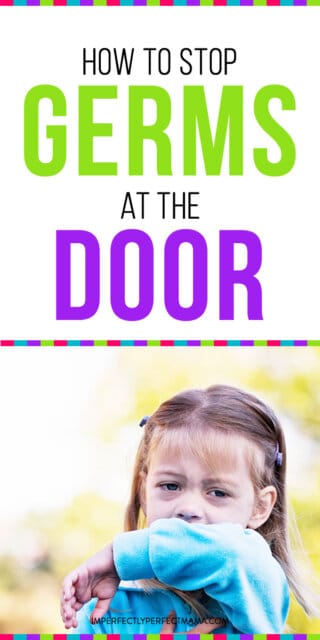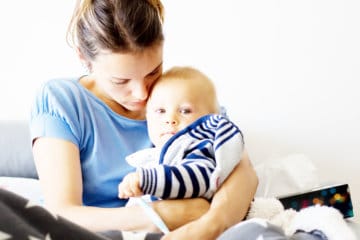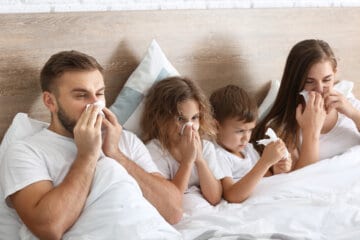Is there anything worse than seeing your little one sick?

It is impossible to keep them healthy 100% of the time, but there are easy steps you can take to combat germs, especially during cold and flu season.
As a teacher and mom, I have developed some simple steps you can follow to help stop germs at your door.
Following these steps can keep the whole family healthy.
Routine for Coming Home
It’s important to have a germ-killing routine that the whole family knows.
You can use this routine after-school, after playing at an indoor playspace, after coming home from an adventure, or any other time you’ve been around lots of people and germs.
The kill-off-germs routine:
- Use hand sanitizer.Upon entering your vehicle, use an alcohol-based hand cleaner. Place a dollop in the palm of your hand and rub until your hands are completely dry.
- Take off your shoes. When you get home, take off your shoes. If you don’t have a mudroom or coat closet near the entry to your home, think about making a space near the front door to house shoes.
- Sanitize your shoes. If you have been walking through a school, nursing home, or playplace, spray the soles of your shoes with a disinfectant spray such as Lysol. This will ensure that they are clean and that any pets sniffing or licking around the shoes won’t pick up germs.
- Wash your hands. The first place you should go when you get home is straight to the bathroom to wash your hands. While washing, teach your children to sing one verse of “Old Macdonald.” This helps ensure that they wash for at least 20 seconds.
- Leave bags at the door. Other than your hands and the bottoms of your shoes, another place where germs may hide is bookbags. Make a conscious effort not to put any bags on your kitchen counter or tables. In our house, we either spray or wipe down the bottoms of bags to try and kill all of those germs. We also hang our bags at the door and then bring in books, folders, papers, or whatever else we might need. Consider leaving your bags, including purses, at your door as well.
- Change your clothes. Since our kids often roll around on floors, play in ball pits, and generally just pick up as many germs as possible, we often have them put their clothes in the laundry and put on different clothes or pajamas as soon as we get home. If your kids have been in an especially germy situation, you may ask them to change clothes when you get home as well.
Healthy Habits
In addition to the kill-off-germs routine, there are also healthy habits you can help develop in your children.
You know they are constantly watching and mimicking you, so make sure you’re modeling these behaviors as well.
Habits to practice daily:
- Handwashing. According to the Centers for Disease Control and Prevention (CDC), handwashing is one of the most effective ways to stop the spread of germs. Always wash your hands after using the bathroom. If everyone sings a verse of “Old Macdonald” while washing, then the kids in the house will just know that’s what is done.
- Handwashing (again!). Another time you should always wash your hands is before preparing food or eating. I’m typically the one preparing food in my house, so my husband and our toddlers go to the bathroom together right before the food is ready so they can wash their hands.
- Doorknob barrier. Use paper towel or a tissue to open bathroom doors when out in public. When we are in the restroom, I repeatedly remind my children not to touch anything. I do this in a playful way by telling them that everything in the bathroom is made of lava. I also make sure to open the door with a paper towel and encourage them to do that at school as well.
- Toothbrushes. Change your toothbrushes. The American Dental Association recommends that your toothbrush be changed at least every three to four months. You should also change toothbrushes after the user has had an illness. And it is never okay to share toothbrushes (yuck!).
- Cover mouths. To prevent the spread of illness, teach your children to cover their mouths when they sneeze and cough. The CDC recommends that you use your upper sleeve or a tissue to cover your mouth rather than your hand. Modeling and reminding is the only way to make this behavior a habit.
- Keep hands away. Encourage your children to not touch their eyes, mouth, or nose. This is very hard to do with younger kids, but explaining the reason why they shouldn’t can often help.
- No sharing. Do not share food or drinks. This is hard to follow, but if you make a conscious effort not to share food with your kids, they will start to follow your lead.
- Toss it. Make sure to throw away tissues or used napkins immediately.
- Learn about germs. Explain the concept of germs to your children. Of course, depending on their age, children might not be able to grasp this rather abstract (to them) concept. However, there are many books and videos out there that can help. The book “Germs Are Not For Sharing” by Elizabeth Verdick is a good one for preschoolers. Simply explaining that you don’t want them to get sick is probably the best approach.
- No sponges. Throw away your sponges. According to Dr. Markus Egert, a microbiologist at the University of Furtwangen in Germany, dirty sponges can contain the same amount of bacteria as human feces. It is unlikely that you’ll be able to clean the sponge. Your best bet is to throw it away and start fresh.
Lifestyle Choices
There are also some lifestyle choices that can be taught at home. These can greatly affect your family’s health.
Lifestyle choices for the whole family:
- Exercise. Of course, there are many health benefits that come from daily exercise. The Mayo Clinic suggests that children ages 3 to 5 stay active throughout the day. Thankfully, most children are inclined to be active anyway. They suggest that children ages 6 to 13 need at least an hour per day of physical activity. You should model exercising with your kids (go on a walk, do a dance together, play in the yard together) to promote healthy habits for the whole family.
- Get plenty of sleep. The National Sleep Foundation has recommendations for how much sleep a child needs at different ages. Make sure your kids’ sleep habits are within those guidelines. Adults should get at least 8 hours of sleep per day. This will keep everyone happy and healthy.
- Eat healthy. There are lots of resources for you and your kids to help you eat healthy. The Mayo Clinic has an excellent guide for kids’ diets that’s broken down into age groups. Keep this guide in mind when preparing meals for the family.
- Manage stress. Everyone in your family can benefit from finding time to relax and de-stress. Find a routine that works best for your family and makes you all feel happier.
- Get a flu shot. The CDC lists many scientific studies that use research to show the importance of the flu vaccine in keeping everyone healthy. Although it is especially important that children, pregnant women, and those with weakened immune systems get the vaccine, the health of the community relies on everyone getting vaccinated.
Keeping It Clean
Finally, regularly cleaning certain areas of your home can help everyone stay healthy.
Create a daily rotation for when these chores are completed.
For instance, complete one area each day of the week and then take the weekend off. Everyone in the house (even kids!) can help with this.
According to an article published by Public Broadcasting Service (PBS), cold and flu viruses can live longer on hard surfaces around your house than they can on more porous surfaces.
This is why it’s important to regularly clean all surfaces.
Clean these areas:
- Mop and disinfect your hard surface floors.
- Wipe down counters, tables, and other surfaces with disinfectant wipes or soap and water.
- Clean and disinfect toilets, faucets, and bathroom surfaces.
- Disinfect doorknobs and light switches.
- Disinfect toys and wash stuffed animals and bedding.
Hopefully, this post has given you some new ideas about how you can prevent illnesses in your family.
Just remember that routines, habits, and choices can go a long way in helping you all stay healthy. Even though you may not be able to stop them from getting any colds or flus this year, you can definitely try.
Do you have any other tips for keeping your family healthy? If so, let us know in the comments.




3 Comments